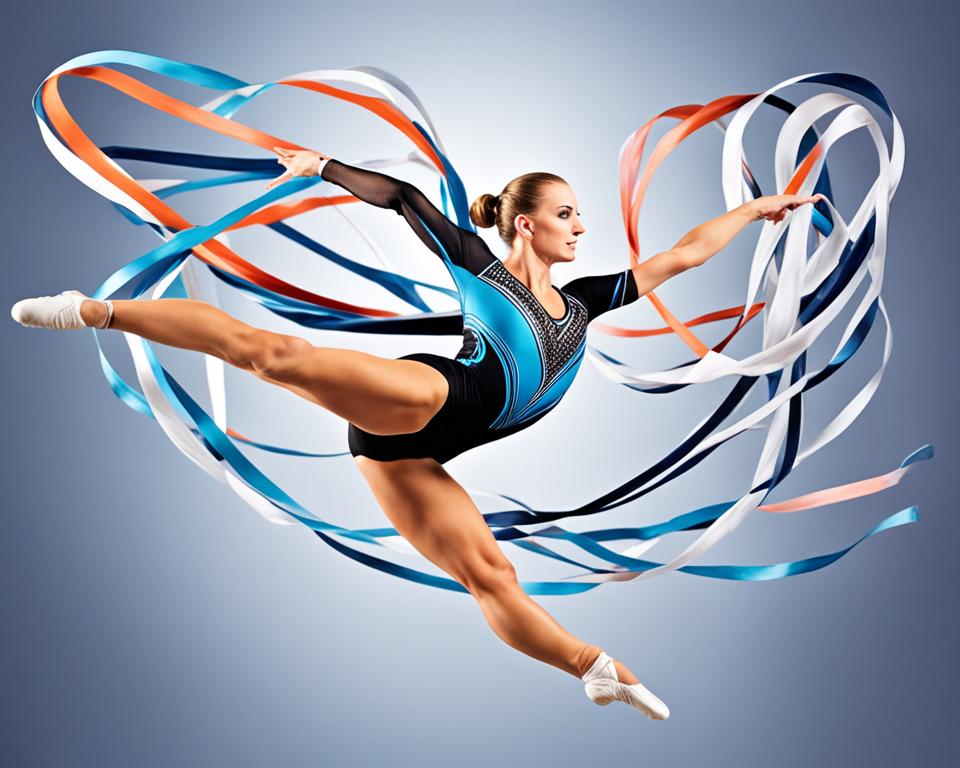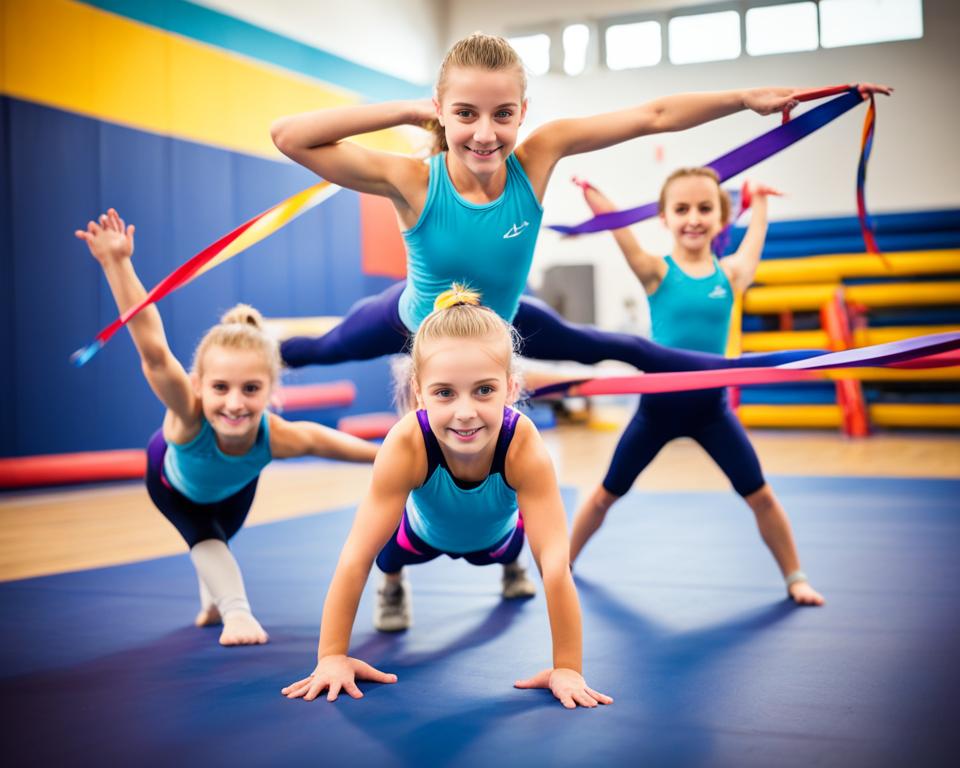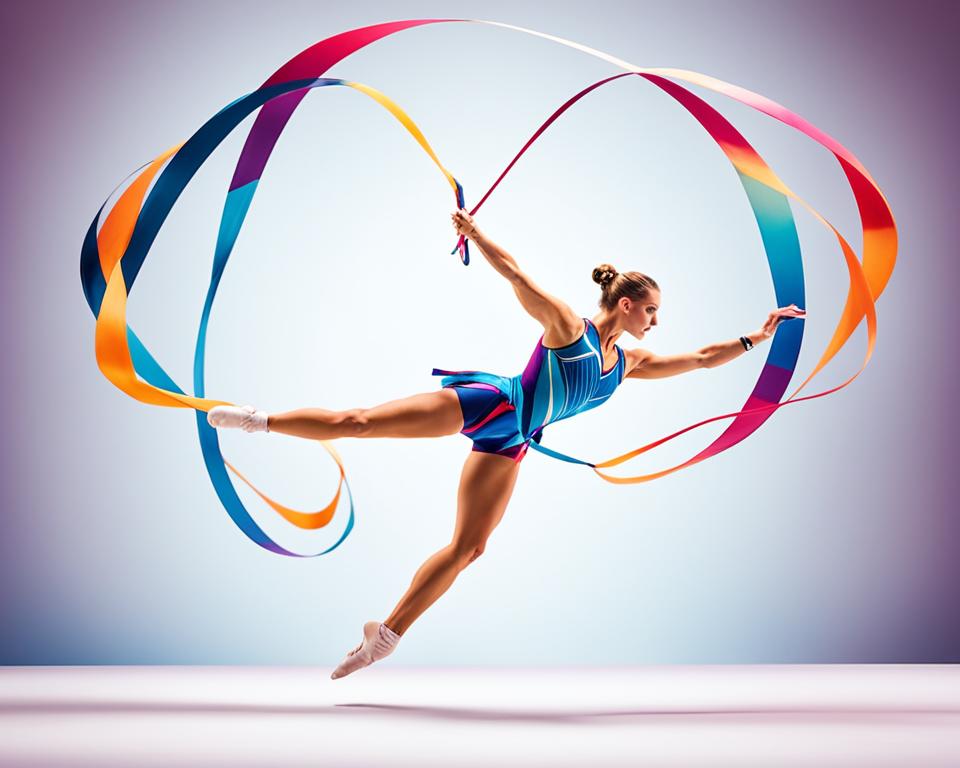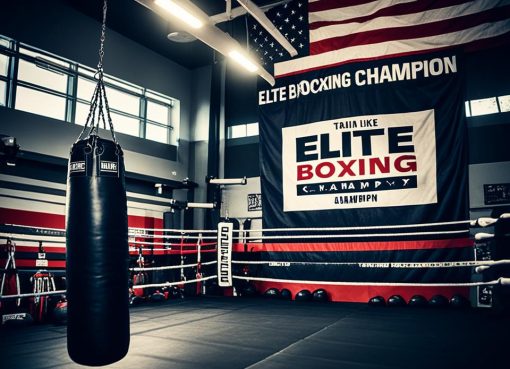Rhythmic Gymnastics: Artistry and Athletic Grace

Rhythmic gymnastics is a mix of athleticism and art. Gymnasts show off their skills with different tools, flexibility, and beautiful moves. This sport has won fans all over the world. It’s a perfect mix of physical skill and beauty.
From using clubs and ribbons to doing smooth, ballet-like moves, rhythmic gymnastics is a unique blend of sport and art.
Read interesting things at : intarajyuku
Key Takeaways
- Rhythmic gymnastics blends athleticism and artistic expression.
- Gymnasts demonstrate mastery of specialized apparatuses, flexibility, and graceful movements.
- The discipline combines the precision of sport with the aesthetic appeal of dance and ballet.
- Rhythmic gymnastics captivates audiences with its mesmerizing routines and athletic grace.
- This article explores the intricate details of rhythmic gymnastics, from equipment handling to scoring criteria.
The Mesmerizing World of Rhythmic Gymnastics
Rhythmic gymnastics combines the beauty of ballet with the strength of traditional gymnastics. Gymnasts show off their skills with smooth moves, complex dance moves, and the use of special tools. Their performances are a mix of art and strength.
This sport values the body’s ability to move with precision and beauty. Gymnasts work hard to improve their ballet skills. This helps them get stronger, more flexible, and balanced. It also lets them add emotion and art to their routines.
The dance moves in rhythmic gymnastics show the sport’s artistic side. Coaches and gymnasts work together to make routines that look great with tools like hoops, balls, clubs, and ribbons. These routines are visually stunning and grab the attention of everyone watching.
This sport requires a mix of strength and artistry. Gymnasts need to be physically strong to do hard moves. They also need to be expressive to make their routines beautiful and captivating. This mix makes rhythmic gymnastics a sight to see.
Apparatus Handling: Mastering the Art
Rhythmic gymnastics is a captivating sport that requires gymnasts to masterfully handle various apparatus. The clubs and ribbons are two key pieces of equipment that need exceptional control and artistry.
Clubs: Twirling with Precision
The clubs are a key part of rhythmic gymnastics, known for their sleek design. Gymnasts learn to twirl the clubs in complex patterns. They move the clubs from their hands to their bodies and the floor smoothly.
This skillful handling of clubs wows the audience and shows the gymnast’s technical skill.
Ribbons: Flowing with Grace
The ribbon adds a beautiful visual to rhythmic gymnastics routines. Gymnasts use the ribbon’s natural flow to make stunning patterns. They move the ribbon through the air with grace and control.
This lets gymnasts show their artistry, making the ribbon part of their movements.
“The ribbon is the most challenging apparatus to master, as it requires a delicate balance of strength, coordination, and artistic interpretation.”
Handling the clubs and ribbons well shows the skill and hard work of rhythmic gymnasts. Whether it’s twirling clubs or flowing ribbons, their mastery is impressive.
Flexibility and Coordination: Keys to Success
Rhythmic gymnastics is a captivating discipline that requires high levels of flexibility and coordination. Gymnasts need to twist their bodies into complex positions while keeping control and balance. This lets them perform complex routines with ease and beauty.
Flexibility is key in rhythmic gymnastics. It lets gymnasts move and express themselves in amazing ways. They need to do high kicks, splits, backbends, and contortions. Their flexibility is crucial. Coordinated movements are also key for smooth handling of apparatus and dance-like moves.
- Gymnasts must have great flexibility to do complex movements and positions.
- Good coordination is important for combining apparatus handling and graceful moves.
- Together, flexibility and coordination help rhythmic gymnasts perform their routines with amazing skill and beauty.
Improving flexibility and coordination is a lifelong journey for rhythmic gymnasts. They aim to expand human movement and expression. With hard work and deep knowledge of their sport, these athletes amaze audiences with their stunning performances. They mix the beauty of dance with the strength of athleticism.
“Rhythmic gymnastics is the ultimate fusion of grace and strength, where the body becomes a canvas for artistic expression.”
Artistic Expression through Movement
Rhythmic gymnastics lets gymnasts show off their art through movement. They take inspiration from ballet’s grace and fluidity. This creates a unique style that wows the crowd and makes their performances unforgettable.
Ballet Skills: A Graceful Foundation
Rhythmic gymnasts work hard on their ballet skills. These skills are key for their expressive routines. They learn precise footwork, elegant arm movements, and beautiful pirouettes. This makes their routines look poised and elegant.
Adding ballet to rhythmic gymnastics mixes athleticism with art. Gymnasts move smoothly from powerful tumbling moves to gentle, flowing ones. They tell stories and express feelings through their moves, amazing the audience.
“Rhythmic gymnastics is not just about technical execution; it’s about the ability to captivate the audience with your artistry and emotional expression. The fusion of ballet and gymnastics is what makes this sport truly unique and mesmerizing to watch.”
By mastering ballet and adding it to their routines, these athletes take their performances to new heights. They show off both athletic skill and emotional expression. This creates a stunning display that leaves a strong impression on everyone who sees it.
Choreography: Bringing Routines to Life
Creating a rhythmic gymnastics routine is a detailed process. Gymnasts and choreographers work together to make routines shine. They pick music, design movements, and use apparatus in creative ways. This turns routines into stunning shows that highlight the gymnasts’ skills and beauty.
Choreographers mix technical skills with artistic flair in rhythmic gymnastics. They plan each move to make routines flow smoothly. Every action, from ribbon sweeps to club twirls, is thoughtfully designed for a beautiful show.
Working together is key in rhythmic gymnastics. Gymnasts share their skills, and choreographers shape them into routines. This teamwork leads to amazing performances.
“Choreography is the heartbeat of rhythmic gymnastics. It’s where the gymnast’s athleticism and the choreographer’s vision come together to create something truly magical.”
Rhythmic gymnastics is always changing, making choreography more important. New choreography ideas, like adding contemporary dance and unique apparatus use, make the sport exciting. They draw in fans all over the world.
The mix of choreography and athleticism defines rhythmic gymnastics. It turns the sport into a blend of art and sport. Gymnasts and choreographers keep wowing audiences and inspiring new fans.
The Glamour of Leotards and Costumes
In the world of rhythmic gymnastics, leotards and costumes are more than just clothes. They are key parts of the sport. These outfits add beauty and elegance to the performances.
Design and Sparkle on the Floor
Rhythmic gymnastics leotards and costumes show off creativity and cultural flair. Designers use sparkles, bright colors, and detailed patterns. This makes the outfits stand out.
Leotards are made with top-quality fabrics for flexibility. They let gymnasts move freely. Costumes can have flowing skirts, detailed embroidery, or props like veils. These add more beauty to the show.
| Leotard Design Elements | Costume Design Elements |
|---|---|
|
|
The mix of these design elements makes the performances visually stunning. As gymnasts move, their outfits add to their artistry. This makes the sport even more beautiful to watch.
Competition Rules and Scoring Criteria
Rhythmic gymnastics competitions follow strict rules and scoring. These rules look at how well gymnasts do their moves, how artistic they are, and how well they use their equipment. It’s important for both the athletes and the audience to know these rules to enjoy the sport fully.
The Fédération Internationale de Gymnastique (FIG) sets the rules for rhythmic gymnastics. These rules cover things like the makeup of the routines, what equipment is allowed, and how judges score. They make sure the competitions are fair and consistent.
- Routine Composition: Gymnasts must do a routine with different moves like body movements, leaps, and handling the equipment. The routine must fit within time limits and show a mix of skill and beauty.
- Apparatus Handling: Gymnasts use one of five equipment types: hoop, ball, clubs, ribbon, or rope. Each piece has its own way of being used, and gymnasts must show they know how to use it well.
- Scoring Criteria: Judges look at the gymnasts’ performances with a detailed scoring system. They look at technical skill, artistic impression, and how well the routine is done. Technical scores check the difficulty and quality of moves. Artistic scores look at how well the gymnast shows feelings and expression.
| Scoring Category | Description | Maximum Score |
|---|---|---|
| Technical Merit | Evaluation of the difficulty and execution of the performed elements | 10.0 |
| Artistic Impression | Assessment of the gymnast’s ability to convey emotion and expression through their movements | 10.0 |
| Execution | Evaluation of the overall quality and precision of the routine | 10.0 |
Rhythmic gymnastics competitions are complex and demanding. They show off the athletes’ skills and artistry. The rules and scoring make sure the sport is both exciting and a true test of skill and creativity.
Rhythmic Gymnastics: A Blend of Sport and Art
Rhythmic gymnastics combines sport and art in a unique way. Gymnasts need great strength, flexibility, and coordination. They also need to understand art, choreography, and movement. This mix makes a show that grabs people’s attention all over the world.
Balancing Athletic Prowess and Artistry
A rhythmic gymnast must balance their athletic skills with art. They perform complex routines with tools like ribbons, hoops, balls, or clubs. At the same time, they tell a story with their moves.
This sport tests both the body and mind. Gymnasts challenge their limits while staying graceful and expressive. The mix of sport and art makes it special, offering a unique experience for viewers.
“Rhythmic gymnastics is the harmonious union of physical ability and artistic expression, where the gymnast becomes a living, breathing work of art.”
The mix of athleticism and art is what makes rhythmic gymnastics stand out. It wows audiences and motivates future gymnasts to aim high.
Training Regimens for Peak Performance
Mastering rhythmic gymnastics requires hard work on both the body and mind. Top athletes spend many hours improving their skills. They do tough strength and conditioning workouts and practice their moves and routines carefully.
Rhythmic gymnasts show their hard work and focus through their training. They do various exercises to improve their flexibility, coordination, and athletic performance. These exercises include:
- Stretching and flexibility exercises to help them move smoothly and gracefully
- Strength training for their core, upper body, and lower body to do complex routines
- Coordination drills to make sure they can use tools like clubs and ribbons with their movements
- Cardio exercises to get them ready for the long competitions
They also work hard on their artistic expression and performance quality. This means practicing their dance moves, ballet, and how to express feelings in their routines. They aim to impress the audience with their rhythmic gymnastics skills.
“The true essence of rhythmic gymnastics lies in the harmonious fusion of athleticism and artistry. It is a pursuit of perfection, where every movement is imbued with grace and power.”
These gymnasts work very hard to be their best. Their dedication and constant effort show how far they can go in rhythmic gymnastics.

The Evolution of Rhythmic Gymnastics
Rhythmic gymnastics has a long and interesting history. It started in ancient times, where dance and movement were key parts of culture and religion. Over time, it has changed, mixing old traditions with new ideas. Now, it’s a dynamic and captivating sport.
From Ancient Roots to Modern Spectacle
The early beginnings of rhythmic gymnastics can be seen in the graceful dances of ancient Greece, Egypt, and India. These early dances and movements turned into more organized forms. This led to the rhythmic gymnastics we see today.
As the sport grew, it added elements from ballet, acrobatics, and new ways of using apparatus. This made it a modern spectacle that amazes people all over the world with its beauty and skill.
“Rhythmic gymnastics is a unique blend of ancient roots and modern elegance, where the performers seamlessly merge physical prowess with artistic expression.”
The growth of rhythmic gymnastics shows how adaptable and committed its athletes are. From its ancient roots to its modern spectacle, it continues to amaze and inspire. It pushes the limits of athletic grace and artistic skill.
Iconic Rhythmic Gymnasts and Their Legacies
Rhythmic gymnastics has seen many talented gymnasts leave a lasting mark. From pioneers to today’s stars, they’ve inspired many. These icons have made the sport a true blend of art and athleticism.
Alina Kabaeva is a Russian legend known for her mesmerizing routines. She went beyond winning medals, raising the sport’s profile and inspiring others. Her impact is still felt today.
Evgenia Kanaeva is another name from the sport’s history. A two-time Olympic champion from Russia, she dominated in the late 2000s and early 2010s. Her skill and performances made her one of the best ever.
Yana Batyrshina is a Russian gymnast known for her unique style. Her creative routines and dynamic performances have changed the sport. She encourages gymnasts to aim high.
| Iconic Rhythmic Gymnasts | Achievements and Legacies |
|---|---|
| Alina Kabaeva |
|
| Evgenia Kanaeva |
|
| Yana Batyrshina |
|
These iconic gymnasts have made a lasting impact on the sport. They inspire athletes to excel and explore new limits. Their legacies will keep rhythmic gymnastics exciting for years to come.
The Mental Fortitude of a Rhythmic Gymnast
Rhythmic gymnastics is a sport that mixes physical skill with art. It’s not just about the beautiful moves and performances. It’s also about the mental strength these athletes have. They need focus, resilience, and mental discipline to do well.
These gymnasts face huge mental challenges. They must keep their focus while doing complex routines. They move smoothly and show emotion in their moves. Competitions are tough, making them deal with a lot of pressure and high expectations.
Building mental strength is key for rhythmic gymnasts to be the best. They need to handle their nerves, stay calm when things go wrong, and keep going even when training is hard. Being able to see themselves winning, handling competition stress, and getting over losses is crucial.
The mental strength of rhythmic gymnasts is just as important as their physical skills. They have a unique mental toughness that lets them excel in their sport. Their mental journey shows how powerful the human spirit is and how the mind can overcome physical limits.
“In rhythmic gymnastics, the mental game is just as important as the physical. You have to be able to stay focused, calm, and resilient in the face of immense pressure.”

Fostering the Next Generation of Talents
The future of rhythmic gymnastics is in the hands of young talents. With dedicated coaching and training, this sport will keep its legacy alive. It will continue to blend art and athleticism beautifully.
This sport requires strength, flexibility, and creativity. It’s important to support young gymnasts and improve their skills. Coaches are key, guiding them with skill and passion.
Special training programs are vital for future champions. They focus on building strength, improving coordination, and learning complex techniques. This includes handling tools like ribbons and hoops.
Competitions and performances are crucial for these talents. They let young gymnasts show their skills and gain experience. This inspires others to follow in their footsteps.
Rhythmic gymnastics is loved around the world. Coaches and the gymnastics community must support the next generation. By doing so, the sport’s legacy of beauty and skill will live on for years.
Conclusion
Rhythmic gymnastics is a mix of art and athleticism that wows people everywhere. It shows off grace, power, and precision. The sport uses special tools and lets gymnasts show their feelings through movement.
This sport keeps getting better and is still a big deal in the world of sports. It combines technical skill with artistic flair. This has inspired many gymnasts to aim for greatness on a global level.
Being good at rhythmic gymnastics is hard both physically and mentally. It takes a lot of hard work, focus, and a love for moving. This mix of being an athlete and an artist is what makes rhythmic gymnastics special. It draws in fans and helps gymnasts chase their dreams.



Leave a Comment